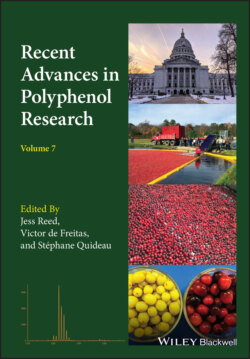Читать книгу Recent Advances in Polyphenol Research - Группа авторов - Страница 50
3.5.1 Phlorotannins in Alaskan Seaweeds/Marine Algae
ОглавлениеAlaska’s Unangan (Aleut) name is Alaxsxix, which means “place the sea crashes against”; as such, it is a rich harvest site for seaweeds all along its 10,690 km coastline. Seaweeds are utilized for food, livestock fodder, and traditional medicines for Pacific Rim Native American, Alaska Native, and First Nation tribal communities. As foods, they provide a limitless resource for macro‐ and micronutrients, and are prepared by drying, toasting, fermenting, and brewing in soups (Kellogg et al. 2015). Recent research has cited the utility of seaweed extracts to significantly increase insulin sensitivity and diminish hyperglycemia (Paradis et al. 2011; Nuno et al. 2013). In partnership with the Southeast Alaska Regional Consortium and Alaska Native elders, we were able to engage in a deeper analysis of the phytoactive constituents of seaweeds and their relevant bioactivities. Extracts from six species of seaweed and one tidal plant were screened for antioxidant capacity using first the mobile biodiscovery kits (described previously) to establish “first hits,” then in both chemical and in vitro bioassays, and total phenolic content was gauged. A brown seaweed (Fucus distichus) proved to have both the highest total phenolic content (557 μg/mg extract, measured in phloroglucinol equivalents) and one of the highest radical scavenging activities (Kellogg and Lila 2013). Follow‐up work established that the phlorotannin oligomers (fucophloroethol structures with DP from 3‐18 monomer units) of F. distichus (Figure 3.3) were involved in potent α‐amylase and α‐glucosidase inhibition, suggesting a mechanism for their traditionally recognized antidiabetic properties (Kellogg et al. 2014).
Table 3.1 Portfolio of mobile biodiscovery training modules used in workshops with both elders and youth in participating native communities.
| Module ID | Approximate workshop time required to conduct the bioassays/procedures | How long before results can be evaluated | Relevant‐disease targets |
|---|---|---|---|
| Field collection* | 2–3 hours | n/a | n/a |
| Plant material extraction | 1–2 hours | n/a | n/a |
| Antibacterial assay | 2–3 hours | 24–48 hours | Bacterial pathogens |
| Antioxidant assay | 1 hour | Immediate | General health |
| Glucosidase and glucosidase inhibitor assays | 2 hours | Immediate | Metabolic syndrome type 2 diabetes |
| α‐amylase inhibition | 1–2 hours | Immediate | Metabolic syndrome type 2 diabetes |
| Anthocyanin detection | 1 hour | Immediate | General health |
| Protease and protease inhibitor assay | 30 minutes–1 hour | 10 minutes | Digestive diseases Viral pathogens |
| Planaria lethality assay | 1–2 hours | 8–24 hours | Parasitic worms |
| Planaria regeneration assay | 1–2 hours | 5 days | Parasitic worms |
| Nematode lethality assay | 1 hour | 4 hours | Parasitic worms |
* Field identification of medicinal plants and sample collection are conducted in concert with local elders from the community.
Figure 3.2 Alaska Native youth engage in a workshop featuring simple mobile biodiscovery assays during a 2019 fish camp on the Yukon River in Alaska.
Source: Mary Ann Lila.
Crude extracts from the same six Alaskan seaweeds were assayed for inhibition against five common inflammatory markers (COX2, iNOS, TNFα, IL‐10, and MCP‐1). While red and green seaweed species exhibited some activity, the brown seaweeds demonstrated significant anti‐inflammatory capacity against all five markers. Subfractionation of the brown seaweed F. distichus revealed modulation in a dose‐dependent manner by some fractions of lipid metabolism gene expression in an adipocyte model. Multiple anti‐inflammatory properties in both adipose and macrophage cells were revealed, and two natural product classes (long chain mono‐ and polyunsaturated fatty acids and phlorotannin oligomers) were linked to these biomarkers (Kellogg et al. 2015). The multifunctional activities of edible seaweeds towards inhibition of the cardiometabolic risk factors associated with metabolic syndrome were linked to high phenolic content and coincident angiotensin converting enzyme I inhibitor activity and anti‐inflammatory activities (Rico et al. 2018).
